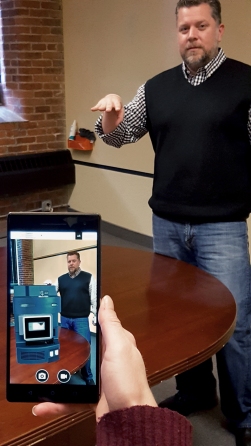In a world of constant change, many successful companies are now adopting a digital engagement strategy across their entire customer lifecycle. Interactive experiences on websites, smartphones and tablets are everywhere we turn these days. And now we are about to be driven by immersive experiences. Many of these new marketing technologies are being adopted in the B2C world, but B2B companies must also take notice. Succeeding in B2B marketing depends on how well companies understand the systemic changes that are now imperative in engaging prospects and retaining customers. B2B marketers can look towards a new kind of immersive technology: augmented reality (AR) to help deliver their stories and demonstrate the outcomes of their products and solution s.
s.
Augmented reality is the ability to take a real-time camera view of a physical space and superimpose digital objects within that space virtually. In true AR, the product is scaled correctly so that the digital object fits perfectly into the physical space. One popular application of AR is consumer games, such as Pokémon Go, which allows B2B marketers to take note on how this type of technology can be utilized in their field and give them a meaningful competitive advantage. Rather than blindly implementing a new technology, B2B marketers must effectively use AR so that it adds quantifiable value to their business. AR provides companies with a new way to explain their complex value propositions with an entire new set of tools. Not only does it bring in three dimensions, but also allows direct user interaction.
According to a report by Forrester Research, technology like AR, helps companies also create new customer loyalty opportunities and improve customer service effectiveness. The report claims that AR allows companies to better personalize their products/services to the consumer’s frame of reference. This allows for an enhanced emotional connection during the customer engagement which creates concrete memories and lasting impressions. As customers interact with the AR application, they absorb more information because they are so emotionally connected to the experience itself. Marketers can utilize this advantage in a variety of different ways within their B2B business. An article from the Optera Group explains four possible use cases for AR in the B2B space: product development and prototyping, marketing large complex products, communicating value propositions and trade show and events.
Augmented Reality is taking B2B marketing to the next level by amplifying the customer’s experience throughout the entire buying process and allowing them to understand exactly how your solutions fit into their world. These experiences create a transformative effect on the customer that will help demonstrate the product’s value within every business setting.
Learn more about our current offerings here www.kaon.com.

